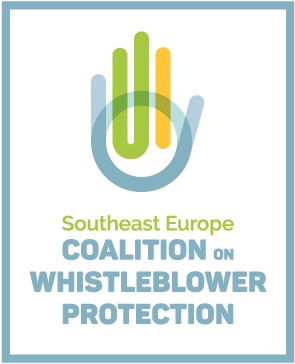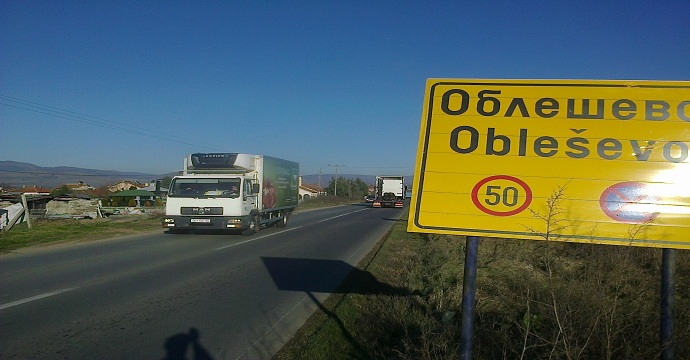The express road project in Eastern Macedonia of 23 million Euros, as promised by the ruling party in the last election, has become more expensive to 56 million, not for a highway, but for expansion of the existing road which should become express road. The study of a German company, however, shows that the highway will cost 70 million Euros. Residents of the surrounding areas are in panic for their safety.
“Here is the road Stip – Kocani, too. With reconstruction of this road as express road, the speed limit from the current 50-70 km/h will increase, the existing width of the road will be reconstructed and expanded in length of 26 km. The route starts from Stip, continues in several settlements and ends in Kocani. This is an investment worth 23 million Euros”, this is the decision that VMRO-DPMNE placed to about 200,000 citizens of East Macedonia in the last election in its program “Provereno”.
For clarification, the express road is a two-way road with 2 lanes of 3.5 meters for driving in both directions, and a lane of 2.45 meters on both sides for a vehicle to stop.
This research will show that the project is far from “verified” from several aspects.
The most important thing is that the expansion of the road Stip – Kocani will not cost 23 million Euros. SCOOP addressed the Agency for State Roads to respond where in the VMRO-DPMNE program it was announced that the express road will cost 23 million Euros. So far, unofficially from this agency they have said they are working on the calculations and cannot say how much it will cost.
Anonymous sources from the Agency for State Roads for SCOOP say they do not know how come in the VMRO-DPMNE program it came out that this road would cost 23 million Euros.
Neither in the European bank, where the loan was raised of 160 million Euros to build a highway from Struga to Trebenista, express road Ohrid-Pestani, rehabilitation of 10 km of road Prilep-Gradsko and express road Stip-Kocani, do they know what the final amount of the express road will be. For more detailed information they sent us to the Agency for State Roads.
In the public debate in the village of Obleshevo in September this year figures were mentioned bigger than 40 million Euros.
On Kocani TV Kanal 8, where deputy director of the Agency for State Roads Aleksandar Stojanov gave a statement, it was mentioned that the section would cost 56 million Euros, double more than the money listed in the VMRO-DPMNE program.
A lot of money for little work
For the same section, “DIWI Macedonia”, a subsidiary company of the German company “DIWI International”, has prepared a feasibility study for highway, in which the same section has been estimated to cost 70 to 80 million Euros.
SCOOP has made a calculation how much each additional square meter asphalt will cost, that is, what will people of Eastern Macedonia get for the money that will be invested. Table 1 presents two options express road and highway of 26 kilometers as stated in the VMRO-DPMNE program.
The table clearly shows that each additional square meter asphalt surface with the express road will cost the state 490 Euros per square meter while for the highway the citizens of Macedonia will allocate 150 Euros per square meter.
The decision of the Government and the Agency for State Roads with 56 million Euros to build an express road with additional two lanes is very illogical, and with 70 million Euros a highway can be built, says Stojce Samardziski, economist from Stip.
“This decision has no economic logic. For 75 million Euros we will have six lanes with a total width of 19 meters, I mean the highway and plus existing national road. On the other hand, for 56 million Euros we will have an express road (existing plus additional two lanes on the side for stopping of 2.5 meters, total of 5 meters)”, says Samardziski.
He adds that it is illogical for 75 million Euros to have two facilities to Kocani, one will be the current main road, and the second will be a highway that will connect to the new road from Miladinovci to Stip built by the Agency for State Roads. While with the proposal of the Government, for 56 million Euros we will have a problematic facility that will be built with much trepidation, because traffic will be diverted. If a highway is built, we will not have these problems, says Samardziski.
For Sasko Stefanovski, Geography professor interested in connecting Kocani with a quality traffic link, the express road will be the “end” for Eastern Macedonia.
“Adding two meters of asphalt on the side is only throwing dust in our eyes. These two meters will only open problems for this region. The express road will be the end for Kocani, Vinica, Berovo, Delcevo, Pehcevo and Makedonska Kamenica”, adds Stefanovski.
He adds that if they build an express road, in the next 50 years Kocani and the region will not see further investments in road infrastructure.
The express road will destroy the water infrastructure of HS Bregalnica
Along the express road Stip-Kocani there are drainage canals, concrete canals and irrigation canals. With the express road this infrastructure will be buried and a new one will have to be made. According to the director of HS Bregalnica Kocani, Zoran Belicev, the Agency for State Roads must enable this infrastructure.
“We will not give consent for the Agency to displace our ditches and canals unless it finds an appropriate solution for them to be in operation”, Belicev is straight.
He adds that the dislocation of infrastructure of HS Bregalnica along the current road A3 (future express road from Stip to Kocani) is not a simple thing.
Irrigation ditches should be set by contour lines, that is they have to pass on the highest points of the territory they irrigate, while for the drainage channels they should go after the lowest points. A complete project for the displacement of this infrastructure should be done.
50-year-old farmer from the village Cheshinovo Sane Jovanov says it is easier to cope with the irrigation canals, but with drainage channels there will be many problems. He reminds that all the villages in the Kocani valley such as Cheshinovo, Uljarci, Chiflik, Obleshevo, Dolni Podlog, Mojanci and Grdovci can be flooded if there is no adequate drainage system.
Village Obleshevo will be “cannon fodder” on the express road
Obleshevo is shrouded in fear and ignorance of the express road. Many people are afraid about how the traffic in their village will be organized. This settlement may have the most victims of accidents in the country. According to the memories of the inhabitants of this village, so far more than 60 people from the village have been killed on this road.
“We still have fresh memories when two girls from the village were run over at the same time on this road. We had to strike so that they put a protective fence along the road”, says 40-year-old resident of this village.
His fears are that the express road prepared by the Agency for State Roads will increase the risks of accidents in this village.
According to the statements of the designers of public debate in this village starting from 30 September, no ring road is projected around the village. To the village there will be two lanes to stop from the sides, while in the village there will be only the existing road. Current speed on the road of 80 kilometers per hour will be increased to 100 kilometers and that speed will apply before the village. Drivers in the village itself will have to reduce speed to 50 km per hour.
This gives a lot of doubts among the villagers.
“Current speed limit before the village is 80 kilometers per hour, rarely any driver reduces speed to 50 kilometers per hour. I can imagine what will happen when the speed limit will be 100 kilometers per hour. 2-3 km before and after the village it is flat, and they will drive very fast. I am afraid that we will be run over like frogs”, says 39-year-old Goran.
He adds that the police should constantly have two points at the entry and exit of the village not to be run over by cars.
The Agency for State Roads did not respond how they would solve the problem with the village Obleshevo and whether there will be a ring road built. We also asked the European Bank for Reconstruction and Development, in conjunction with this project, but there we were sent for a response to the Agency for State Roads.
Agricultural mechanization on the road in the future, too
The danger to find farm machinery on the road is great. The Agency for State Roads predicts construction of two gullied roads from 3.5 meters on both sides of the express road. These lanes will be used for agricultural vehicles, but the problem is that with the express road closure is projected of local footpaths leading to the fields in the villages Chiflik and Uljarci. They have to drive a few kilometers on the road to reach their fields.
“I do not know how it will be with the express road. But if there is no bridge at the village Chiflik nobody will drive 4 km in one direction and 4 in the other and vice versa to get to their field. All these tractors and combines will drive without lights at night through the express road as it is now with the main road”, says a resident of the village of Chiflik.
He expects that in terms of traffic safety with the express road, conditions will deteriorate.
35-year-old Stojan from Kocani also does not expect improving driving conditions with the express road.
“Road Agency will build gullied roads along the express road, but in the Kocani part of the road there are several marshy areas, just this year next to the road a combine fell, the tampon will fail, too and tractors will again be on the main or in the future express road”, says Stojan.
He fears that the express road is not suitable for the conditions on the land and that instead of unloading the traffic, it will be a “slaughterhouse”.
Overtaking is risky
Overtaking on the express road is symptomatic, fear connoisseurs of traffic conditions in Kocani.
“Bends will be corrected, and ridges will be aligned. On the road it will be allowed to drive 100, and drivers will practice to drive up to 130 km per hour. On the road there will be trucks that will drive at 40 km per hour. There will be a lot of overtaking. I doubt there will be many direct crashes because traffic will go both ways and only in two lanes. I do not even want to think what will happen to the passengers and drivers in a direct crash, if both vehicles are moving at over 100 kilometers per hour”, says a driving instructor from Kocani who wanted to remain anonymous.
He passes the road Stip – Kocani several times a day with his candidates.
According to Deputy Director of the Agency for State Roads, Aleksandar Stojanov, two new asphalt lanes will function for overtaking. “The lanes for stopping can be used, slower vehicles to move aside” said Stojanov for the Kocani TV Channel 8.
However, from the Agency for State Roads they did not answer whether slow vehicles make a traffic offense by stopping on the stop lane? In the public debate those responsible for designing the road did not answer whether with this statement Deputy Director urges drivers to violate traffic rules even before they build the road?
Unanswered by the Agency for State Roads remained the question whether the additional lane of 2.45 meters will be a lane only slow vehicles to stop or a lane for stopping and moving aside of trucks, as Deputy Director of the Agency for State Roads said?
The express road will be too narrow 3-4 years after construction
According to the study for highway solution of DIWI Macedonia, in 4-5 years the section from Kocani to Stip will have enough traffic for highway in full profile, or 12,000 vehicles daily average. It means that only four years after the express road will be built, it will be too narrow for all the vehicles that will run on it.
Residents of Kocani think the government is not thinking long-term on development of this region. For 33-year-old Zoran L., Government should plan long-term development of the region, not only for the next 2-3 years.
“The most long-term project of this government is until the next election. They do not think that construction facilities in Eastern Macedonia should serve future generations”, says Zoran.
Otherwise, in construction, long-term plans include a period longer than 10 years.
(The story was is supported within the NED project “Raising Awareness about Corruption through Investigative Reporting”)








